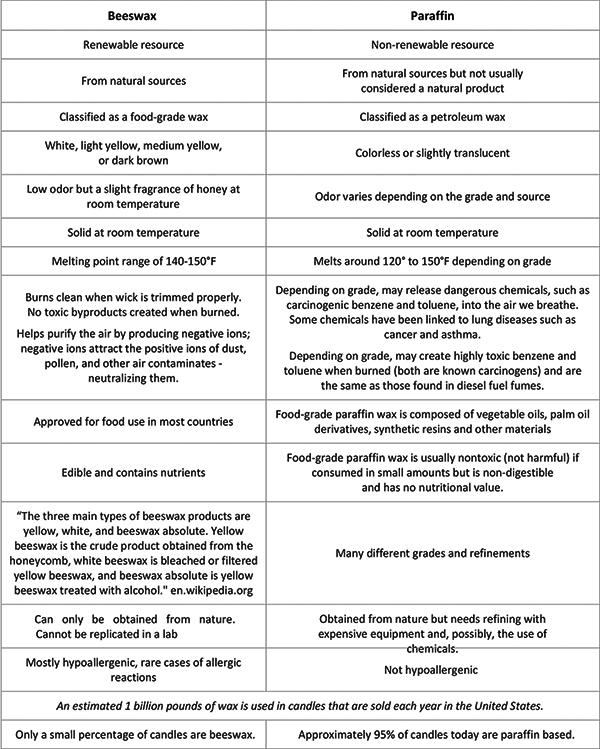
Melondy Phillips
Staff Writer
Approximately 95 percent of candles made today are made with paraffin wax. Although there are different grades of refinement, paraffin wax is a byproduct from the refining of lubricating oil; a petroleum product. Paraffin wax was first produced in 1830. During a time when most candles were made from tallow, paraffin wax quickly took off since it was cheaper and burned cleaner. Paraffin wax is also used to make Vaseline; a type of petroleum jelly.
Separating and cleaning the paraffin wax from crude oil is a multi-stage process that takes special equipment and supplies. Sciencedirect.com states, “Two types of processes are used; selective hydrocracking and solvent dewaxing. In the former, one or two zeolite catalysts are used to selectively crack the wax paraffins.”
Pure beeswax is a natural substance that can be cleaned and used in most any household, with limited equipment.
I have read several statements online about how taking wax from honeybees is harmful and inhumane. From a beekeeper’s point of view, with more than 15 years of experience raising honeybees, I would say I disagree with those statements and here is why.
Bees will be bees. They will continue to work whether you interact with them or not. They also don’t look around and think “oh, my home is full; I think I’ll take a vacation.” Healthy hives will always produce far more wax, honey and propolis than they need. In the wild, honey bees will keep expanding their comb into whatever “container” they are living in. When there is no more room to expand, they will either swarm (about one-half of the hive leaves to find a new home) or they abscond (the entire hive leaves). Another possibility can take place. On a few occasions, when I would be busy with other things and had to leave my bees to themselves for extended periods, they would become honey-bound.
Honey-bound is when the field bees are bringing in a lot of nectar and the house bees start back-filling into the brood section of the hive. The queen, therefore, has no cells to lay new eggs in. With no new eggs being laid, the number of bees starts to decline. If numbers fall too low, the hive will not survive the winter.
When harvesting honey, I normally only collect the capping wax, the top part of the wax that seals the honey into the comb. This is a very clean and light colored wax. I don’t like throwing away perfectly good resources, especially when it has so many important uses. Every so often, however, frames do need to be scraped so that the bees have a fresh start. With each generation, the size of the brood chamber cells gets smaller and darker. There is a buildup of larval cocoons that bees spin inside the cells as they grow. This brood wax may also contain “significant levels of contaminants including pesticides, heavy metals, fungi, bacteria and viruses.” (www.bee culture.com)
The smaller cells produce smaller, less productive honeybees, which can eventually lead to the death of the whole hive. The wax harvested from these brood frames comes out a darker yellow color after it has been cleaned. The cells that contain the bee bread, or processed pollen, will also darken as it ages.
It’s easy to see that a responsibly harvested hive, of both honey and beeswax, actually helps to keep the hive healthy and growing. Furthermore, I believe it is prudent not to waste the surplus of this natural renewable resource.
The chart below shows a comparison between bees-wax and paraffin wax.

When making beeswax candles, just adding a bit of coconut oil to the beeswax can help slow down the burn time and prevent tunneling of thicker candles.
Maybe it’s just me, but there is something about the soft warm glow and subtle fragrance from a handmade beeswax candle that I can’t get from a paraffin wax candle; a feeling of simplicity and nature.
Time to start dipping more candles…


